RARE! WWII 1944 Battle of Biak (Schouten Islands, New Guinea) “Hurricane Task Force” 24th Infantry Division & 41st Infantry Division Invasion Combat Map





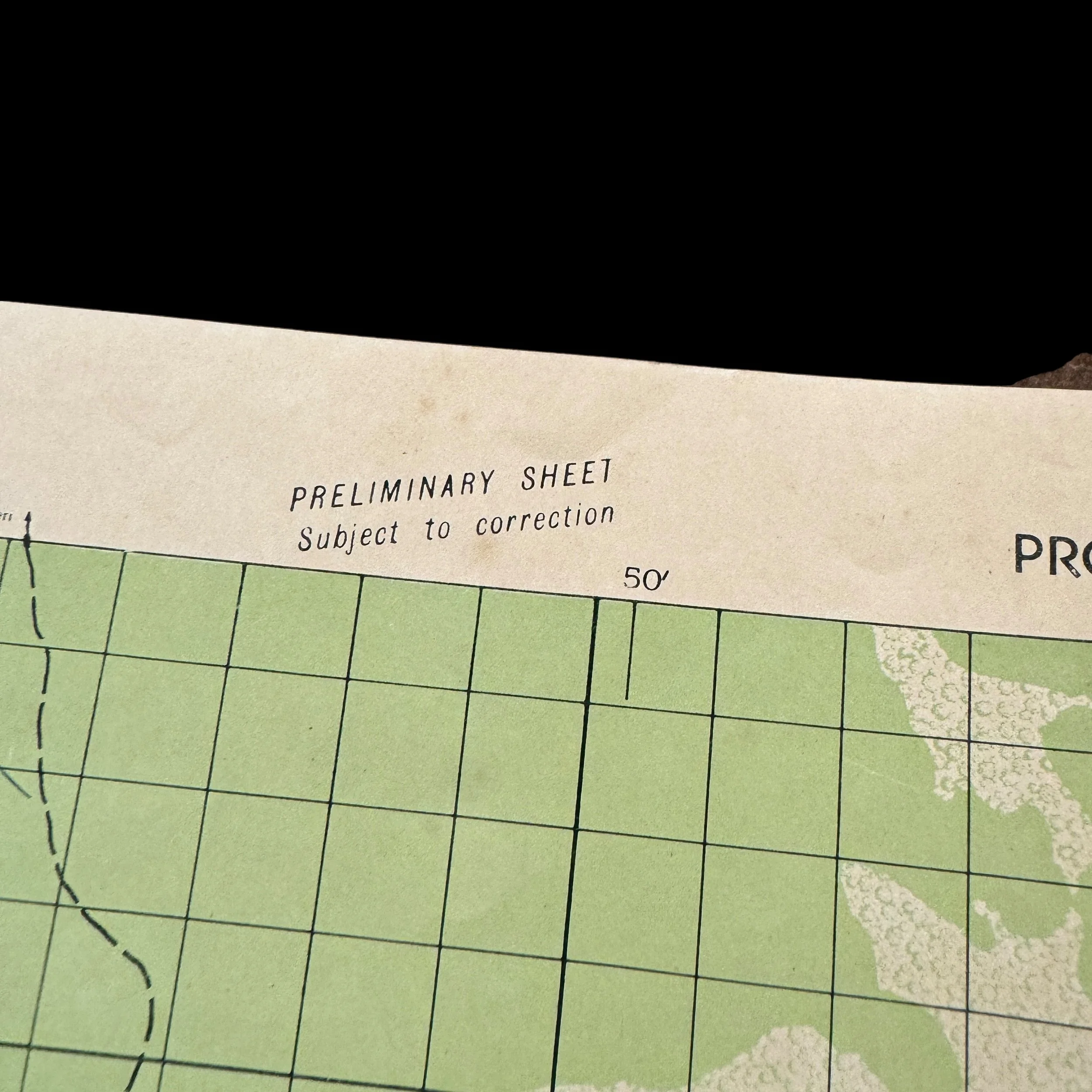


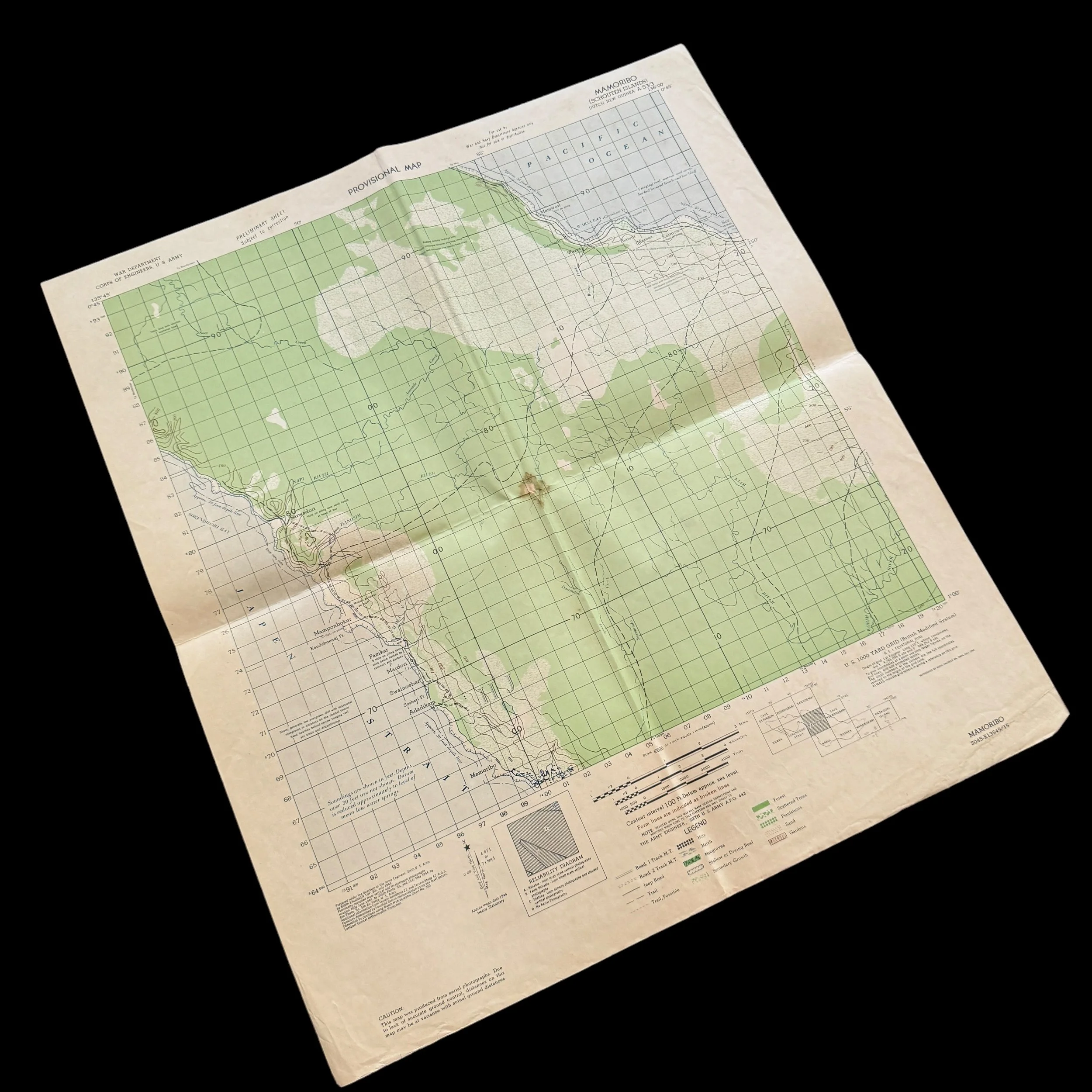
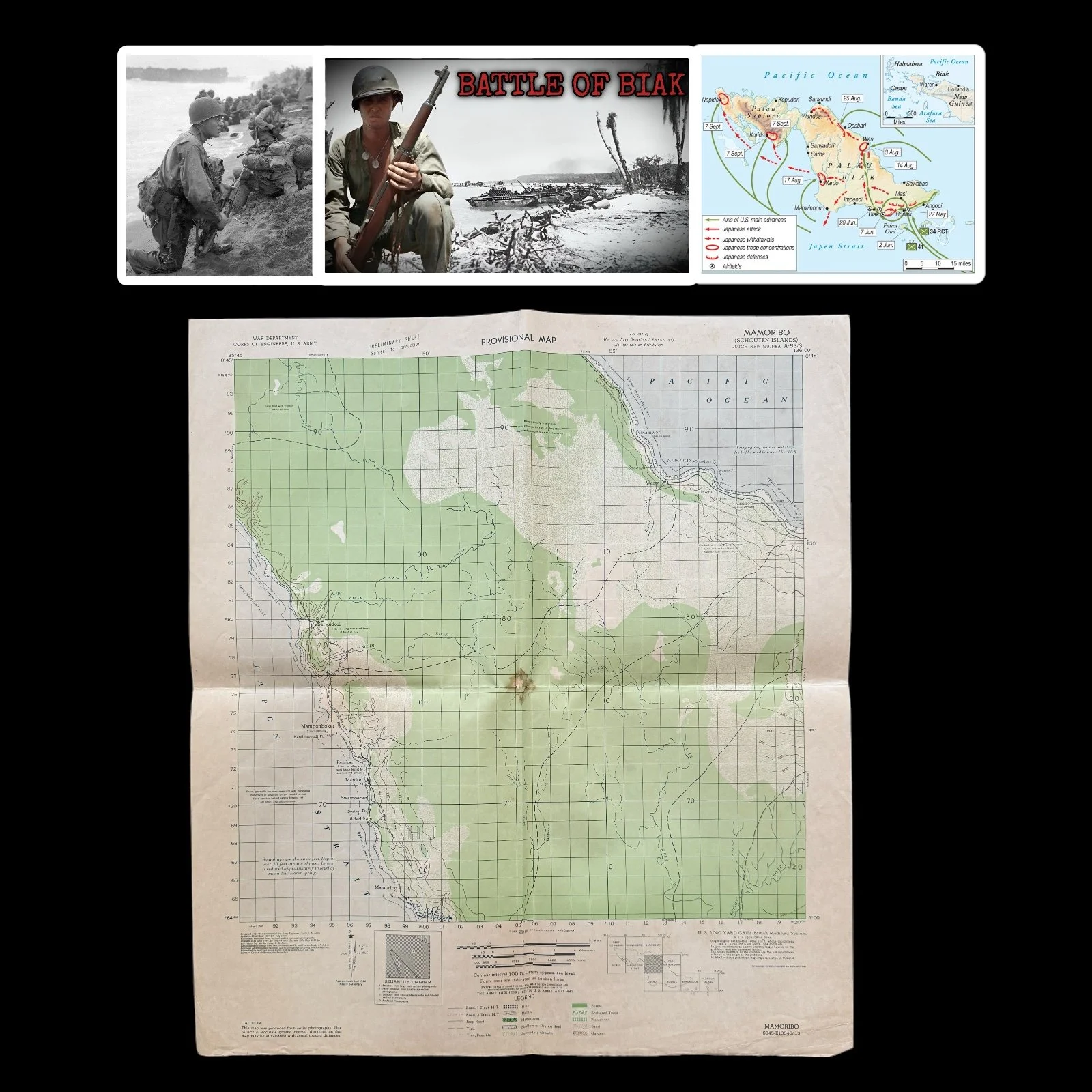


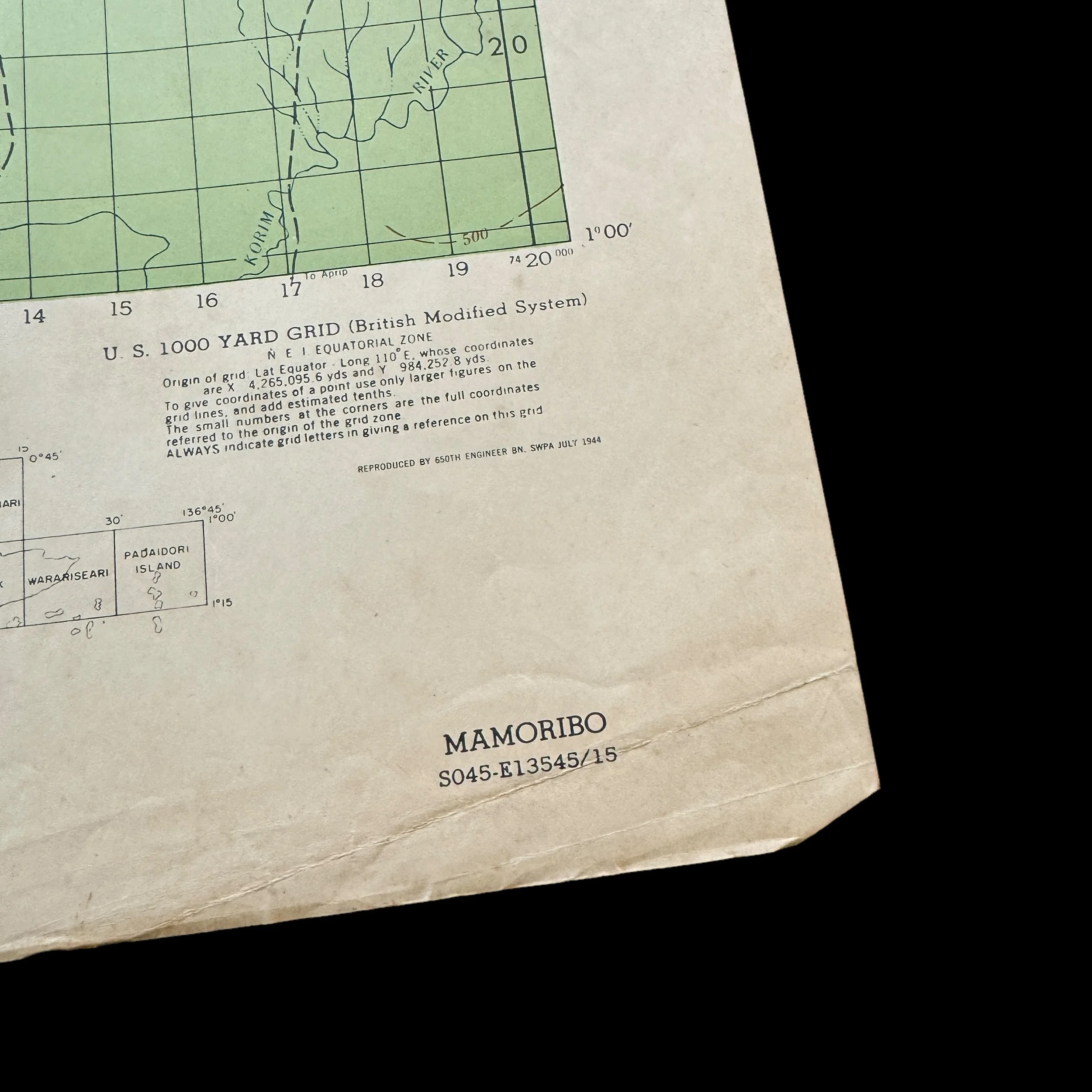

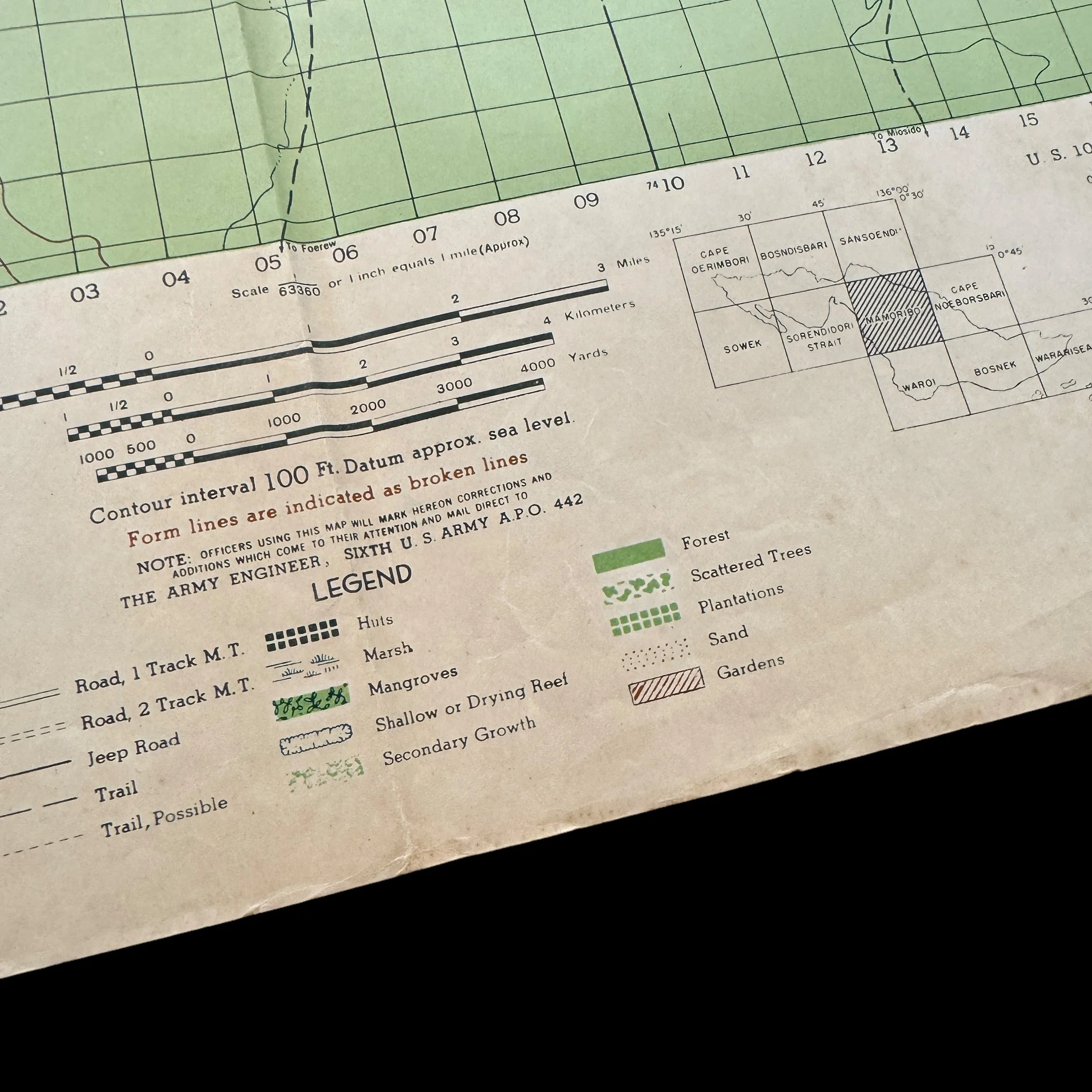
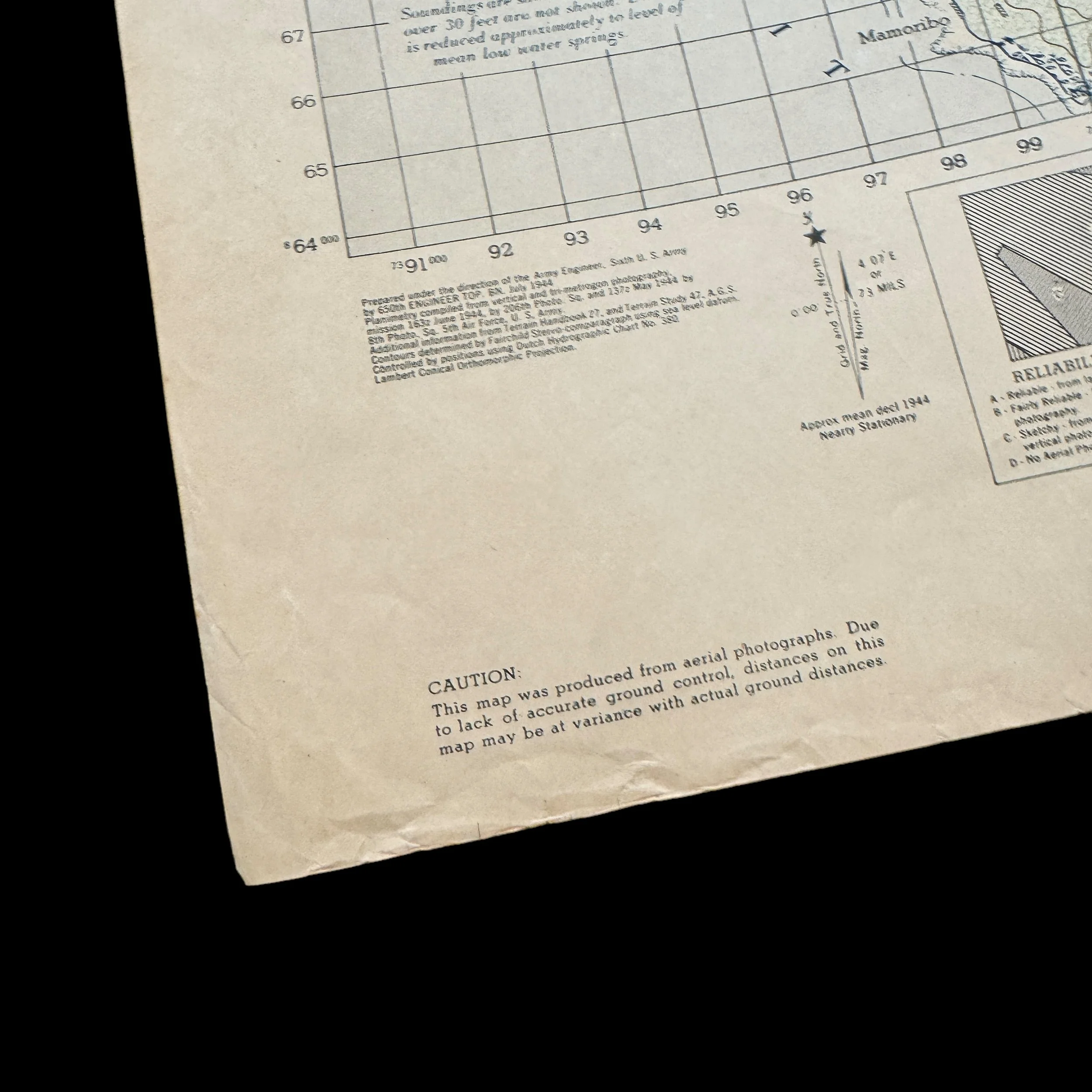
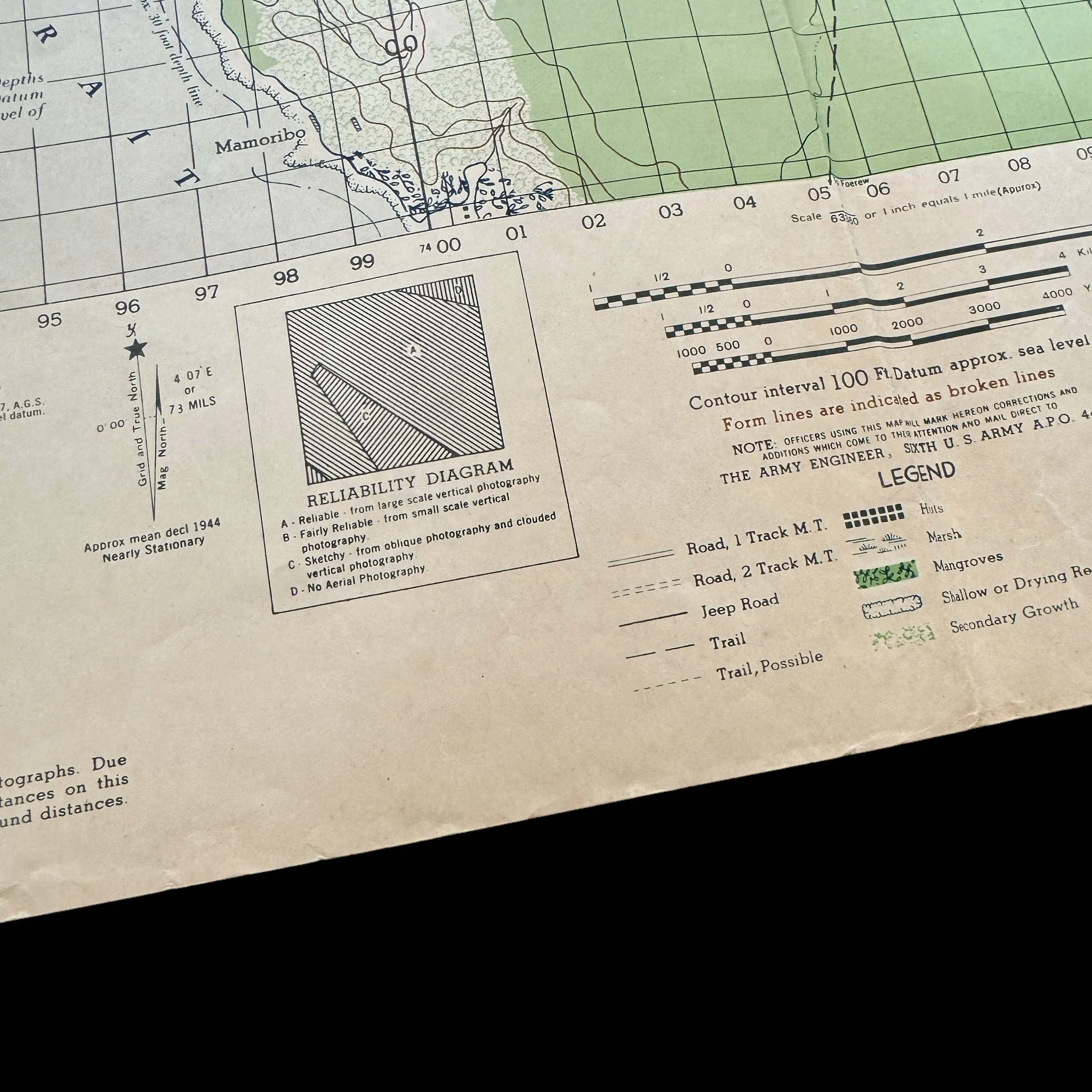



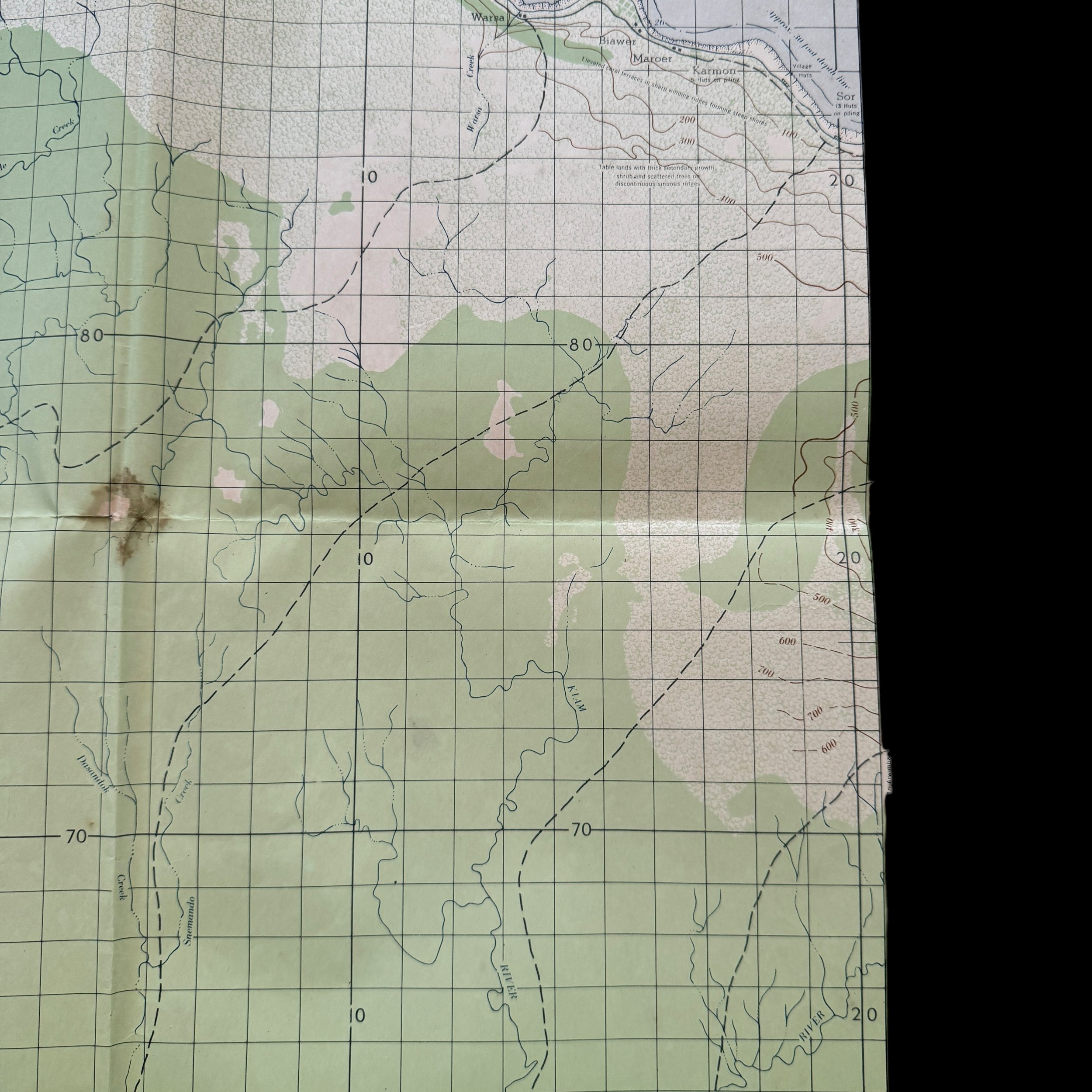


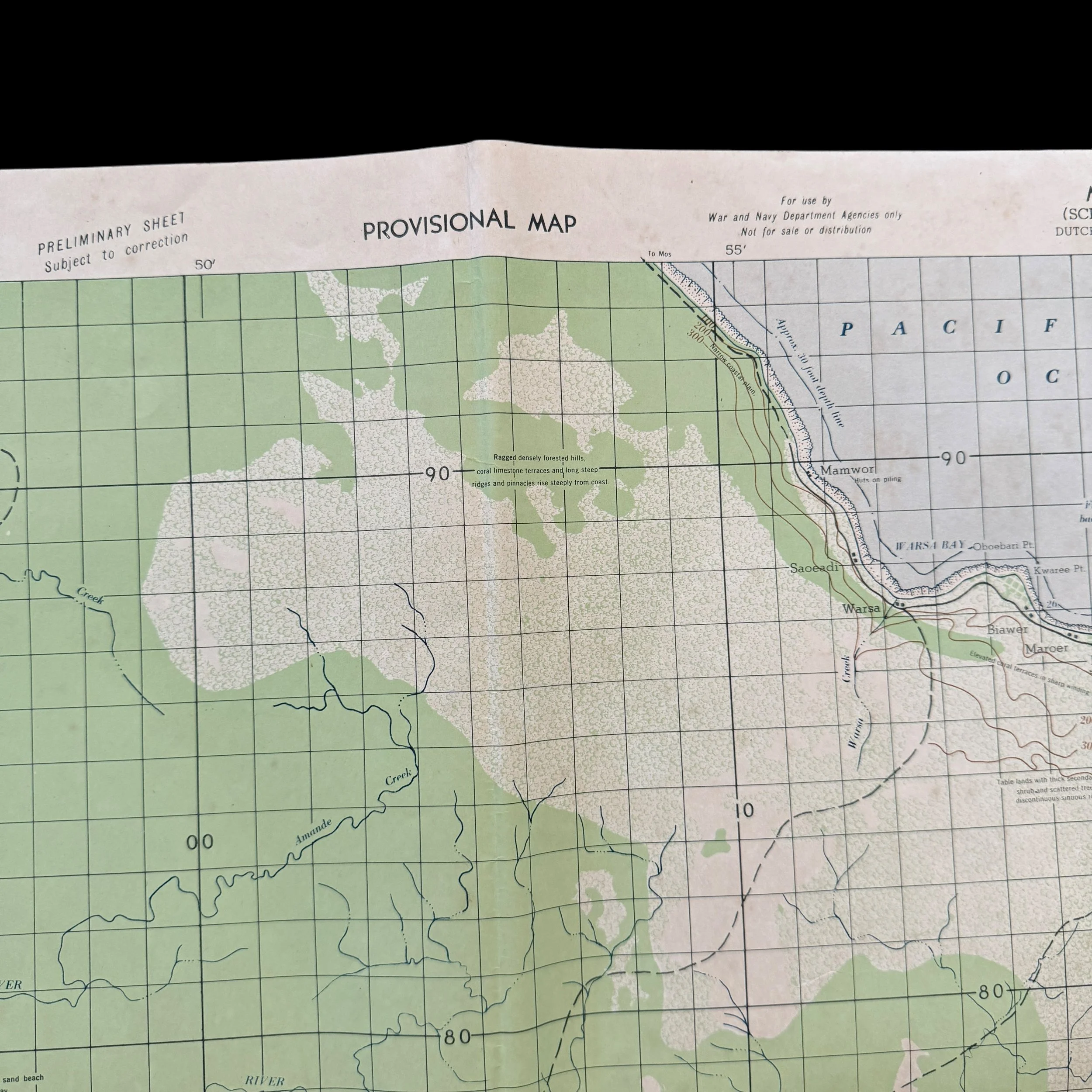
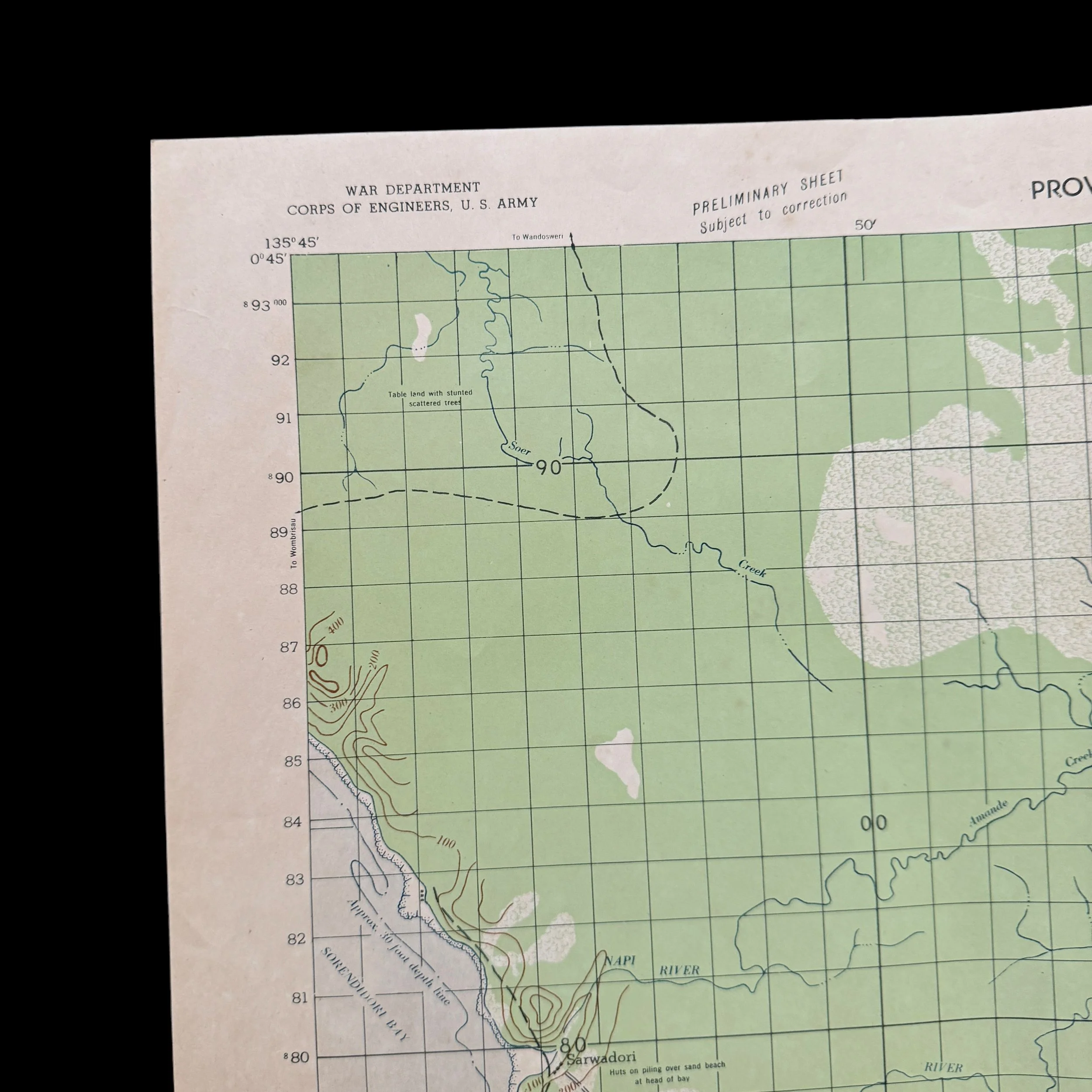
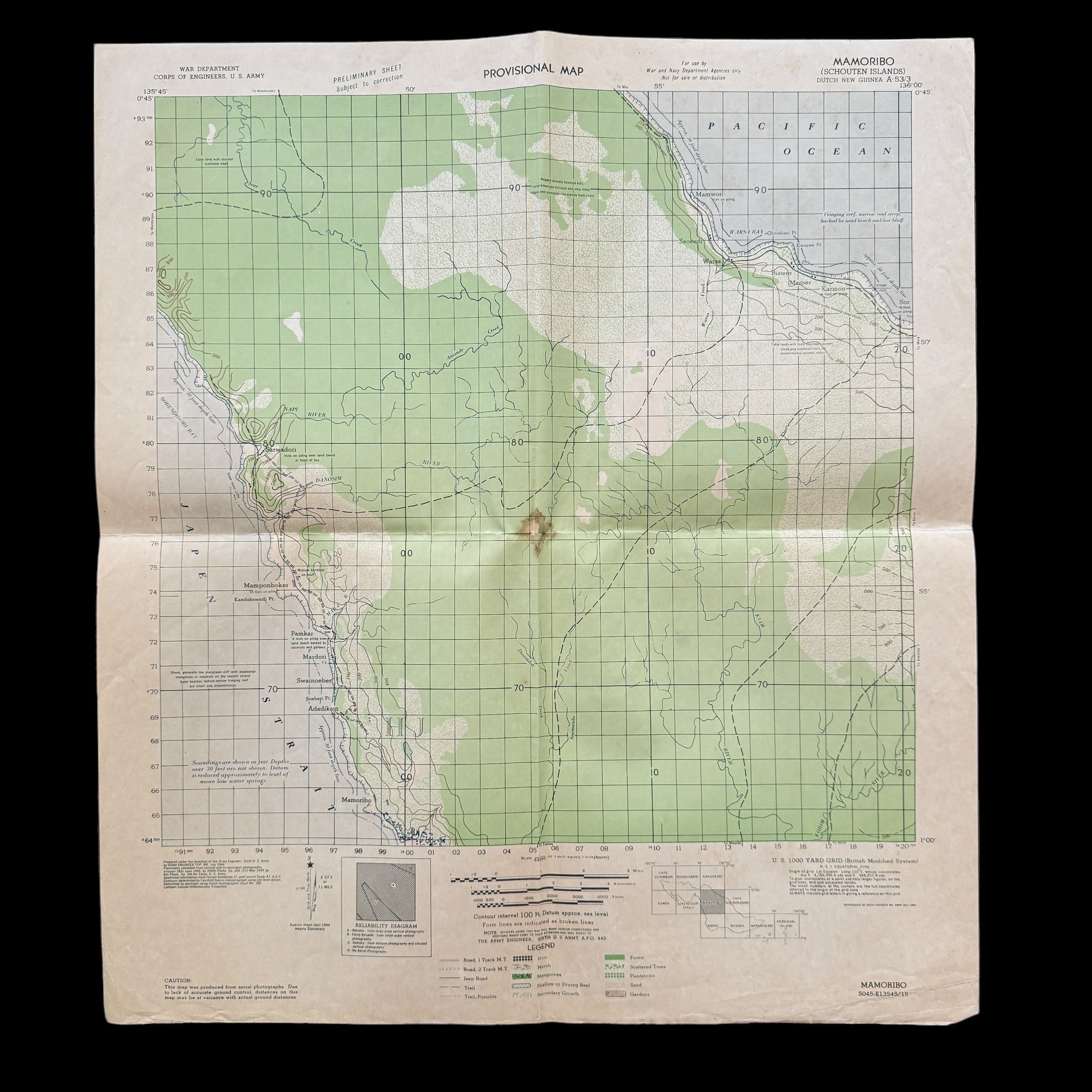
RARE! WWII 1944 Battle of Biak (Schouten Islands, New Guinea) “Hurricane Task Force” 24th Infantry Division & 41st Infantry Division Invasion Combat Map
Comes with a hand-signed C.O.A.
Size: 20 x 22.5 inches
This incredibly rare and museum-grade WWII artifact is an original 1944 dated Battle of Biak (Schouten Islands, New Guinea) combat map used by the U.S. “Hurricane Task Force” 24th Infantry Division and 41st Infantry Division during General Douglas MacArthur’s New Guinea Operations in the Pacific Theater. The Battle of Biak would go down in WWII history as General Douglas MacArthur’s costly victory that paved the way for his return to the Philippines.
Colonel Harold Riegelman admitted he knew little about Biak, a strategic island in New Guinea, before landing there in June 1944. The U.S. Army’s 41st Division had been fighting Japanese forces on Biak since May 27, 1944, aiming to capture its three airfields at Mokmer, Sorido, and Borokoe to support future operations in the Philippines. Initially, resistance was light, but Japanese forces, unexpectedly numbering over 11,400, soon fortified their positions in caves, significantly delaying the American advance.
On May 27, 12,000 U.S. troops landed using amphibious vehicles due to a coral reef, but progress was stalled by intense Japanese resistance from fortified cave positions. Despite heavy naval and artillery support, the 162nd Regiment faced significant challenges, requiring a tactical withdrawal and re-landing. The Japanese counterattacked with light tanks, but American Sherman tanks repelled them effectively.
The battle for Biak's airfields involved grueling jungle warfare, intense heat, and severe water shortages. The Japanese used complex cave systems for defense, making them hard to dislodge. Flamethrowers, satchel charges, and TNT were employed to clear the caves, resulting in gruesome scenes. The 163rd Regiment reinforced the effort, capturing Mokmer airfield by June 7, but it remained under Japanese fire until the caves were cleared.
General MacArthur replaced General Fuller with Brig. Gen. Jens A. Doe due to slow progress. American forces continued clearing caves using brutal methods, with engineers using 850 pounds of TNT to demolish particularly stubborn positions. By late June, the West Caves were cleared, and Mokmer airfield became operational. The East Caves near the original landing beaches were cleared by July 5, ending significant Japanese resistance.
Despite the high costs, including nearly 500 American dead and over 2,400 wounded, the operation secured Biak as a critical air base, aiding future Allied operations in the Philippines. The campaign revealed the brutal nature of cave warfare and the fierce resolve of Japanese defenders, epitomized by Colonel Kuzume’s final stand and the desperate Japanese counterattacks.
WWII Battle of Biak Operation Summary:
In 1944, U.S. and Australian forces began "island hopping" to the Philippines, and the airfields on the island of Biak were the first U.S. objective. Planners forecast a week-long operation, unaware that there were 11,500 Japanese on the island entrenched in large caves which honeycombed Biak's mountainous interior.
On May 27, 1944, the experienced veterans of the 41st Infantry Division, made up originally of National Guardsmen from Oregon, Washington, Idaho and Montana, landed unopposed on Biak. It was a feint: the 41st, which had earned its "Jungleer" nickname in New Guinea, was about to enter its toughest fight of World War II.
Oregon's 162nd and 186th Infantry were moving inland toward the airfields when the enemy struck. The 163rd Infantry (Montana) was quickly brought in to join the horrible jungle fighting, where despite the heat and steep terrain, water was rationed to one canteen every 24 hours.
On June 15, I Corps commander LTG Robert Eichelberger assumed command, prompting a new plan of attack. On June 16th, the 2nd Battalion, 186th Infantry, attacked to close a gap between their regiment and the 162nd. The battalion overran dozens of machine gun nests, log bunkers, and even a naval gun, and opened the battle's second phase when they discovered a second major cave system. These caves were not cleared until June 27th, and not until August 20th would the fight for Biak be declared over.
The brilliant Japanese use of natural defenses foreshadowed later fighting on Pelileu and Okinawa, and as on those more famous islands, the fighting on Biak was costly. Only 10% of the Japanese defenders survived; the U.S. suffered some 400 killed and 2,000 wounded in action, most of them from the 41st Division. Today, the proud heritage of the Jungleers is carred on by the 162nd and 186th Infantry Regiments of Oregon's 41st Infantry Brigade, and by Montana's 163rd Infantry and 163rd Cavalry Regiments.
The Battle of Biak: “A Terrifying Glimpse Into the Soul of Mankind”
“All I knew about Biak was that it was an island a degree south of the equator, one of the Schouten group lying north of Geelvink Bay toward the western end of New Guinea.”
Colonel Harold Riegelman made this admission of ignorance toward the middle of June 1944, shortly after coming ashore on the island. By that time, the U.S. Army’s 41st Division had been fighting its way inland from Biak’s southern landing beaches for nearly three weeks. In the coming weeks and months, Colonel Riegelman would learn more about Biak than he ever could have bargained for.
The landings took place on May 27, 1944, near the town of Bosnik. Opposition from the Japanese troops occupying the island is usually described as “light,” something of an understatement. Resistance was so insignificant that some senior officers speculated that the Japanese had evacuated the island. Actually, the defending Japanese troops had been caught off guard by the landings and were not prepared to make any sort of counterattack. They held their fire, reorganized, and waited for the following day to begin their resistance.
Soldiers asked why this God forsaken heap of jungle rot, coral, and caves had to be occupied. Soldiers in every army, in every era, have asked this question, but senior planners had an answer this time. Strategically, Biak had to be taken. The Japanese had built three airfields on the island—at Mokmer, Sorido, and Borokoe. Capturing these air bases would not only deprive the enemy of their use, but would also put American bombers within 800 miles of the Philippine Islands, where American troops were to land in October 1944.
But the high-level planners underestimated Japanese resistance on Biak. Enemy troop strength was thought to be about 4,400, but actually more than 11,400 Japanese were on the island—well over twice as many as estimated. Planners also thought the occupation of Biak would take about a week. They were wrong about that as well.
12,000 Troops Land on May 27
A coral reef just off the landing beaches created a problem that the naval planners knew something about. The reef ruled out using conventional landing craft for the landings. Instead, amphibious LVTs and DUKWs were employed. Both of these were able to cross the reef, land the troops, and return to LSTs offshore for more troops and supplies. Using amphibious vehicles might have been slightly unorthodox, but the LVTs and DUKWs did the job. All 12,000 troops—the 41st Division, along with the 162nd Regiment—as well as artillery and 12 Sherman tanks were put ashore on May 27. The landings went a lot easier than expected. But, as one officer phrased it, “the worst was yet to come.”
The troops began moving toward the airfields the following morning. Patrols from the 162nd Regiment had advanced to about 200 yards of Mokmer airstrip when defending Japanese opened fire with machine guns and mortars. Limestone caves about 1,200 yards north of Mokmer airstrip constituted the key to the defense of Mokmer village. Another line of caves formed natural defenses north of the village, and a third section of caves to the west of the landing beaches, in an area known as the Parai defile, was fortified with pillboxes. These caves gave the Japanese a great advantage, allowing them to hold up the American advance toward the airfields for nearly a month.
The destroyers USS Wilkes and USS Nicholson came as close to shore as their captains thought prudent, firing 5-inch shells into the Japanese positions near Mokmer, but the Japanese relocated to the Parai defile, where they held their ground and opened a withering fire against the advancing 162nd Infantry. The destroyers came under fire from shore batteries, which damaged at least one of the ships.
“Artillery, machine-gun fire, and mortars plastered our troops,” remembered Colonel Riegelman. “The forward battalion was cut off by an invisible, deadly wall of steel and lead.” The advance of the 162nd had been stopped dead.
The Type 95 Tank vs the M4 Sherman
By this time, it had become clear that the airfields would not be taken until the Japanese were driven out of the caves that dominated the landing area. Dense jungle vegetation, the closeness of American troops to the target area, and especially the cover being given by the caves made it impossible for naval gunfire to rout out the enemy. The 162nd Infantry was hemmed in on three sides and under constant fire from concealed Japanese positions. The men would have to be evacuated from their position if they were not to be annihilated, and there was only one way out—the same amphibious landing craft that brought the troops ashore would have to take them off the beaches.
All available amphibious craft were pressed into service. Under cover of artillery, naval gunfire, and air support, the men were taken off the beaches during the afternoon of May 29. By nightfall, the regiment had been evacuated from Parai and landed about 500 yards away to set up a new position. It had been a near disaster, but the evacuation had succeeded.
The Japanese launched a counterattack the next morning with infantry supported by six light tanks, but Sherman medium tanks from the 603rd Tank Company were on hand to face the attack, having moved up from Bosnik to support the infantry. One soldier compared the appearance of the tanks with a scene from a Hollywood film, with the Shermans coming to the rescue of “the surrounded dogfaces” just in the nick of time.
The Japanese Type 95 tanks, equipped with 37mm cannon, could not do much damage to the Shermans, but the 75mm guns of the Shermans punched holes right through the sides of the Japanese tanks. A 37mm shell hit the turret of one of the Shermans, locking its gun in place. The driver backed into a shell hole, which elevated the front end of the tank along with its gun and allowed the gunner to bring his 75mm to bear on a Japanese tank. The Sherman knocked out the Type 95 in spite of the damage to its turret.
Formidable Cave Defenses on Biak
Stopping the Japanese tanks provided a reprieve for the 162nd Infantry. The men were having enough problems with the island itself. Jungle trails slowed forward movement to a snail’s pace, while equatorial heat slowed the men just as effectively, and fresh water was scarce. The men were limited to one canteen of water per day, which everyone soon discovered was ridiculously inadequate.
The caves gave the Japanese a system of natural defenses that was much more effective than anything they could have built themselves. They allowed Japanese troops to pop out into the open, fire on unsuspecting Americans, and disappear again. Mortars and artillery were also brought into the caves, both to protect them and to keep them out of sight. The “cave defense” was brilliantly effective, much to the frustration of the men of the 41st Division. It quickly became evident that taking Biak would be a long and grim business.
The caves were not just holes in the sides of mountains. Some of them were equipped with electric lights, wooden floors, and kitchens. Some were two and three levels deep. A series of tunnels connected the caves and led to hidden exits. The Japanese “laid ambush after ambush,” one soldier remembered.
The 163rd Regiment arrived on June 1 to reinforce the 41st’s drive toward the airfields. Mokmer drome was captured on June 7, but the airfield was still of no use to American aircraft. Japanese troops in nearby caves kept the Army engineers from making the field operational with steady mortar and artillery fire.
Some of the smaller caves were sealed by a sort of skip-bombing technique by Curtiss P-40 Tomahawk fighter-bombers. Closing others was going to be a long, slow process for the infantry.
“My God, it Looks Like a Scene From Hell”
The capture of Biak was progressing too slowly for General Douglas MacArthur, who had expected to have at least one of the airfields operational by this time. He decided to relieve General Horace H. Fuller of task force command. General Fuller was also commander of the 41st Division and was originally to have stayed on. However, he refused to stay since he felt that he had lost the confidence of General MacArthur. Fuller was reassigned outside the Southwest Pacific Area on June 15. The division was taken over by Brig. Gen. Jens A. Doe, who had commanded the 163rd Regiment.
Soldiers went about the business of clearing the caves with grim determination. Some used flamethrowers, crawling within point-blank range of the entrance under the cover of rifle fire and burning out the cave interiors with long streams of fire. Sometimes the flames would hit one of the cave walls and bounce back at the Americans.
Flamethrowers were unable to reach far enough inside some of the larger caves. Satchel charges, hand grenades, and gasoline were usually employed for these. Gasoline was sometimes poured into one of the openings and then set on fire. After a few minutes, dull thuds and rumblings could be heard coming from the cave’s interior—ammunition supplies were exploding, destroying the cave along with everyone inside it.
The effect of satchel charges was every bit as horrific as that of gasoline. After one cave was blown apart, a private went inside to see what was left. He came out a few minutes later, nauseated and vomiting. “My God, it looks like a scene from hell,” he said. “Pieces of men all over the tunnel floor! Bodies with bellies blown open by concussion! Blood running from the ears, noses, mouths, and eyes of dead Japs! It’s awful!”
In late June the Americans attacked the West Caves, north and west of Mokmer. The infantrymen used gasoline, hand grenades, and explosives to neutralize them one at a time. The deadly work took nearly 10 days and sometimes required the support of Sherman tanks. The caves were finally cleared by the end of the month. Now that they were no longer being harassed by enemy fire, the engineers were able to make Mokmer drome operational. On June 22, the airfield began landing fighters.
Riegelman Studies the Caves
Colonel Riegelman had the chance to take a look around the vicinity of the West Caves and spoke with some of the men who had been engaged in the heavy fighting. He was matter of fact in his evaluation. “I saw the disabled Jap tanks, inspected a nearby mortar platoon, talked to the men, noted their drawn, bearded faces and eyes, red from lack of sleep. They did not complain.”
Riegelman also made a study of the caves on Biak and divided them into four types. Type One consisted of a “cavern in a cliff” from three to five feet in depth, which was used either for a machine-gun emplacement or a storage area for food and ammunition. Type Two was larger, 20 to 30 feet high, facing the sea, with a rear opening from the landward side for access. The cave’s forward opening was “usually improved” by a “concrete machine-gun port” that served to make the already formidable position even more formidable. Type Three was made up of “a series of connected open cavities four to eight feet in height and three to six feet in depth.” Type Four caves were the largest, “more or less circular in shape, up to 50 yards in diameter, 15 to 60 feet deep, with sheer or steeply sloping sides.” The Type Four cave might also be “the entrance to a succession of chambers and interconnecting galleries,” actually a cave network with multiple entrances as much as 100 yards apart. The caves were defensive marvels, but the Americans were becoming experts at improvising methods for neutralizing them.
850 Pounds of TNT
An artilleryman remembered that one cave was “impervious to all calibers we could bring to bear. Its entrance defied demolition.” This was clearly a job for the engineers.
A party of engineers arrived at the cave with what was described as “a quarter-ton trailer” carrying 850 pounds of TNT. A winch was set up, and the TNT was lowered into the cave. “I had no idea what 850 pounds of TNT would do,” an observing officer admitted. “I only knew it was a lot of TNT.”
Nobody else knew what the TNT would do either, but nobody was taking any chances. All troops were ordered back 100 yards from the cave entrance, and nearby Shermans were pulled back to safer ground. Everyone got down on their stomachs, flat on the ground, and waited for the explosion.
When the TNT went off, a cloud of dust and smoke billowed out of the cave, followed by the thud of hundreds of falling rocks. After the smoke cleared, the men and the Shermans were ordered back into position. The men advanced toward the cave’s gaping mouth and stared into the blackness.
“The blackness stared back,” said one observer. The troops sent into the cave were ordered to bayonet every Japanese soldier they could find, whether they were breathing or not.
On June 20, both Borokoe and Sorido airstrips were taken by American troops. The major objectives on Biak—the three airfields—had been captured, but there was still a sizable Japanese force on the island.
About 1,000 Japanese troops occupied the East Caves, situated close to the original landing beaches. They kept up sporadic artillery fire directed at the three air bases. Initially, the fire from these caves had been considered a nuisance. After the West Caves were cleared, the East Caves became the primary objective.
Artillery began firing at the caves shortly after Borokoe and Sorido were safely in American hands. Engineers and infantry from Mokmer moved into the area under the cover of 75mm fire from the Shermans and began clearing the caves using the same methods that had been successful against the West Caves.
Most of the caves had been neutralized by July 5. Their occupants had either been killed or had slipped away into the jungle.
“Score 109 to 1”
Not all Japanese troops took cover in the caves and waited for the enemy to attack. On the night of June 21-22, a counterattack was attempted against the American positions near the West Caves. According to Lt. Gen. Robert Eichelberger, who had been sent to Biak to appraise the situation for General MacArthur, an attack was made by 109 Japanese officers and men against one of the 186th Regiment’s outposts.
“What a racket,” Eichelberger reported. “They came crowding down the moonlit trail in a mass, shouting their banzais.” The 186th’s position was occupied by 12 men who held their fire until the charging enemy was only a few yards away. Machine-gun fire killed many attackers. One Japanese soldier was shot trying to bayonet an American sergeant. Another jumped into a foxhole with one of the Americans and pulled the pin on a hand grenade. The grenade exploded, killing both men. Every one of the attacking Japanese was killed.
“Score 109 to 1,” General Eichelberger said.
Other attacks were made all along the line that night. Each had the same result. Machine-gun fire shredded the Japanese.
“It was mass execution,” one American remembered, “mass suicide of men who wanted to die.” Stories began to circulate about a single squad of Americans killing nearly 200 Japanese. None of them would surrender. They would rather die than give up. One American said, “Usually a sure sign that the Japanese knew that they were licked.”
If the Japanese knew they were beaten, they were not letting it show. The next objective for the American troops, specifically the 163rd Regiment, was the Ibdi Pocket, about 4,000 yards east of Parai. The attack began in mid-June and continued until the end of July. Over 40,000 mortar and artillery shells were fired into Japanese positions during the first two weeks, but the enemy managed to put up stubborn resistance.
By July 10, American patrols reported that the constant shelling had considerably weakened the enemy. The pocket had been methodically blasted away. This was encouraging news for the men of the 163rd as they renewed their attack on July 11. Backed up by artillery, aircraft, and Sherman tanks, infantrymen used flamethrowers and bazookas against the weakened enemy positions.
Progress was slow and costly in human terms. Besides losing more killed and wounded, the Americans were coming down with debilitating illnesses such as typhus and “fevers of unknown origin.”
Using Poison Gas on Japanese Cave Defenders?
Senior officers began looking for a way to end the fighting as quickly as possible. Poison gas was considered and discounted. “We captured a lot of it,” one man said, “just the thing for these caves.”
Colonel Riegelman was asked, “How about it, Chemical Officer? What do you do with those caves?” Riegelman answered, “We got a lot of Jap gas that isn’t being used, sir.” The conversation stopped for a moment. Nobody was sure whether the exchange was supposed to be funny, but it resumed a short while later as if nothing had happened. The joke, if it was a joke, had been dropped.
Sometime after this, the subject of the captured gas came up again. This time, there was no levity. Colonel Riegelman’s commanding officer asked him, “How much Jap gas do you have?”
“Plenty, sir,” the colonel replied. “We have taken great quantities, mostly poison smoke.”
The officer asked Riegelman if the gas could be used against the Japanese and explained that his staff disagreed with his intent to do so if possible.
Riegelman responded, “Sir, in my opinion the staff is right, and I believe you’d be relieved in 24 hours after you used gas. In the end that would cost us more in time and casualties than if we keep on as we are.”
Riegelman did not explain exactly what he meant by “casualties.” He was probably referring to the officers who would face punishment if they elected to use poison gas. He returned to his tent and went to bed. “I never thought I should see the day when I would oppose the use of gas against the Jap, especially his own gas,” he reflected. “Yet I could not think I had been wrong in this.”
“A Terrifying Glimpse Into the Soul of Mankind”
The American forces on Biak kept up their offensive through the month of July, in spite of the heat and the jungle diseases. All organized resistance on Biak ended in mid-July, although mopping-up operations continued until July 25. The island was declared secure on August 20.
Nearly 500 Americans were killed on Biak and more than 2,400 wounded, while another 1,000 were incapacitated by diseases. Japanese casualties were up to 6,100 killed, 450 captured, and an unknown number wounded.
Among the dead was Colonel Naoyuki Kuzume, the Japanese commander. No one is exactly certain what happened to Colonel Kuzume. Some reports claim that he committed ritual suicide after the failed counterattack on June 21-22. Others say that he was killed in action afterward or that he committed suicide toward the end of the campaign.
In his narrative of the Biak campaign, naval historian Admiral Samuel Eliot Morison had nothing but praise for Colonel Kuzume and his defense of the island. “Realizing the hopelessness of his position, this brave and resourceful officer caused his regimental colors to be burned during the night of 21-22 June. Whether he then took his own life or was killed in action is not known, but his death marked the end of a well-directed and stubborn defense.”
Not everyone agreed that the defense of Biak was admirable, no matter how stubborn it might have been. “Biak was a battle that gave a terrifying glimpse into the soul of mankind,” wrote another observer. “For all man’s vaunted civilization and culture, he still retreats into the caves when deadly danger threatens. Under the thin veneer of civilization lurks the caveman—a human animal at bay.”
The Biak operation was a success, which was all that mattered to the military planners. Morison wrote, “MacArthur’s prompt and vigorous invasion of Biak proved to be a serious embarrassment to the enemy on the eve of the Battle of the Philippine Sea. That alone made the operation worthwhile; but, in addition, Biak became an important Allied air base for the subsequent liberation of the Philippines.”